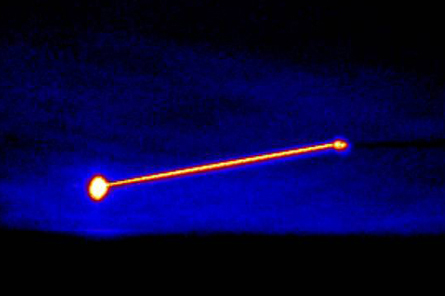The Airborne Laser Testbed (ALTB) faces an uncertain future as both a research project and an operational system even after its 1MW-class chemical laser successfully - and historically - destroyed a ballistic missile off the California coast on 11 February.
The long-awaited intercept test proved that the modified Boeing 747-400F's key technology - a chemical oxygen iodine laser (Coil) invented by US Air Force researchers in 1977 - is a lethal weapon against ballistic missiles.
A week before the ballistic intercept, the ALTB shot down a Terrier Black Brant, a two-stage sounding rocket that presents faster and smaller target to the Lockheed Martin-supplied beam and fire control system.
Moving the ALTB out of the research environment, however, remains an open question. Despite passing a historic milestone for a directed energy weapons system, the intercept was completed in a sterile test environment.
 |
|---|
© Missile Defense AgencyAn infrared image shows the Airborne Laser Test Bed destroying a ballistic target using a high energy laser. |
Moreover, the Missile Defense Agency classified the range of the test and obscured the length of time required to defeat the target, making it unclear how well the Coil technology really performed.
Mike Rinn, Boeing vice-president and general manager for missile defence programmes, believes the lethal demonstration opens the door for high energy lasers to become operational weapons.
"As we show things like we did last night, decisions can be made about whether this platform or some future platform or some incarnation of the current technology can be an operational system," Rinn says.
But Rinn's top customer - Secretary of Defense Robert Gates - remains opposed to making the $6 billion programme operational. In 2009 Gates cancelled the second Airborne Laser aircraft and downgraded the programme from operational prototype to testbed status.
The programme now remains in limbo, awaiting the results of future budget decisions. The Department of Defense has requested slightly less than $100 million for the ALTB in fiscal year 2011, which Rinn says is insufficient to preserve the industrial base for such high-energy lasers.
But the programme's future will be decided in the next round of budget planning. The MDA is working on a study computing the lifecycle acquisition cost of an operational system, which requires buying up to seven aircraft.
Meanwhile, the office of DoD's director for research and engineering is analysing options for missile defences in the boost and ascent phase, Rinn says. That ALTB is a candidate in the director's ongoing analysis, which will inform the Pentagon's FY2012 budget request, he says.
The ALTB is a uniquely complex weapon system, including four different lasing systems. A mixture of chlorine, oxygen and iodine are used to produce photos, which are amplified to create the megawatt-class laser.
The system aims the laser using a deformable mirror, with the imperfections in the atmosphere acting as a lens to restore the quality of the beam before it hits the target.
Source: Flight International
















